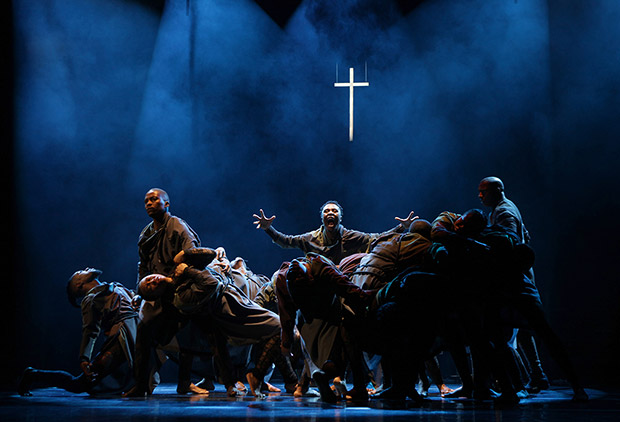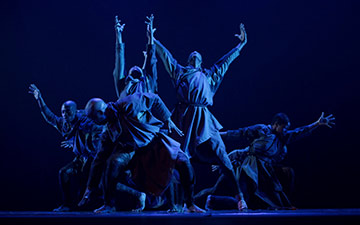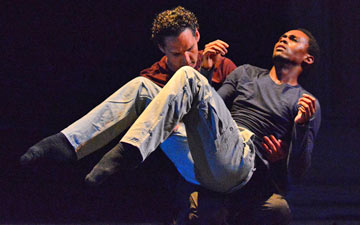
© John Hogg. (Click image for larger version)
Gregory Maqoma
Cion: Requiem of Ravel’s Boléro
★★★★✰
New York, Joyce Theater
January 17, 2020
vuyani.co.za
www.joyce.org
There is a remarkable fusion of music and dance in Cion: Requiem of Ravel’s Boléro, which Gregory Maqoma conceived and choreographed for his company Vuyani Dance Theatre and four musicians who sing in the South African a cappella style Isicathamiya. It was inspired by the character Toloki, a professional mourner in the novels Cion and Ways of Dying by Zakes Mda, who did the text for the production. The music direction and the marvelous and sometimes surprising arrangements are by Nhlanhla Mahlangu.
Cion arrived at the Joyce as part of Prototype, a festival that features “opera/theater/now.” Singers dance and dancers make music in Cion. The dance style itself is a fusion of many elements of South African dance, other African and African diaspora influences, and modern and postmodern dance. It can be both liquid and percussive and has a complexity that is hard to take apart.
Cion is set in a graveyard and there are many crosses on the edges and rear of the stage. Later, the striking lighting by Mannie Manim illuminates a backdrop by scenic designer and technical director Oliver Hauser that looks like fat strips of stonework. But at first it is dark as a dancer wails and cries across the stage in anguished mourning. A simple snare drum rhythm starts and gets denser until we realize that it is the rhythm of Ravel’s Bolero. That is just a hint of how Boléro will be used in the middle of Cion and at the end in novel South African arrangements that revivify it.
The nine dancers, dressed in draped outfits, come to the fore in a cluster out of which arms and legs and bodies forcefully erupt in various ways. There are times these strong, versatile, mobile dancers push and pull in conflict, but in other sections they dance in wonderful unisons or oppositions, styles mutating so that hips flow or body parts bud out, limbs stretch or feet lash out. The singers in an Isicathamiya song about death “who is your Mother” meld voices and let distinct parts ring out – a high voice is particularly compelling.
Otto Andile Nhlapo is the lead dancer who embodies the professional mourner. He wears a robe with a slanted closure. His first solo incorporates moves reminiscent of popping and locking, but different and put into a new context. Later he is targeted, pursued, and overtaken by death and lies on the floor, though he is resurrected for the finale.
For the first Boléro segment a singer vocally beats out the rhythm while others convey the twined strains of melody in a rich mix that makes what can seem overfamiliar wonderfully new. A bass vuvuzela is used effectively as is, later, a harmonica. Mda’s words to Boléro, as translated, speak of oppression and the death of the body, “Death in totality.” An artist statement in the program notes aspects of death that “rise to a catharsis of universal grief.” “Cion, as in Zion, the African church, is a church where the body is religion and the voices are personal.” So it is in Cion, but I didn’t always feel the presence of death in the soaring, involving music and dance, which provided a way of merging with and transcending death.

© Siphosihle Mkhwanazi. (Click image for larger version)
A man intones a monologue, which in translation is a series of “I don’t wants,” including to be taxed, a house, a mattress, any children, and a litany of body parts, but what we hear in a South African language is a forceful rejection that contains repeated sounds. A dancer speaks the “Female Monologue” in English so we understand her story of a “wizened old woman [who] taught mothers to never love their children” and feel the pain of rejecting them. This fearsome withholding of love, one thinks, must be a hardening against the fear of their death.
The musicians are mobile movers and the dancers add sounds to the music. In one section they kneel with cloths that they forcefully smash down to the floor in strong visual and aural rhythms. For the final Boléro sequence the dancers, formerly barefoot and in somber layers, return in hats, swathed in pale cloth, and wearing tap shoes. The dancers vivaciously tap out rhythms, a reminder of how important percussion is in South African dance, a singer beats out the familiar insistent rhythm from Ravel on the side of the drum, and the singers once more make a lush and haunting complexity out of Boléro, in concert with the dancers. Death has been faced, joined, and mourned and now, in music and dance, seems either subsumed or vanquished.

















You must be logged in to post a comment.